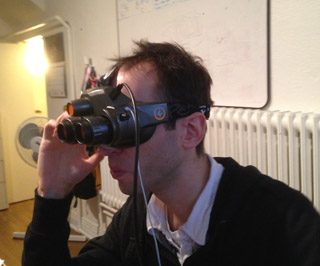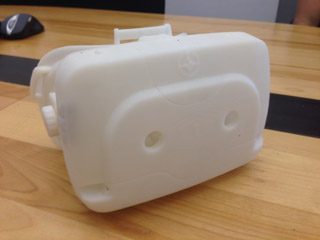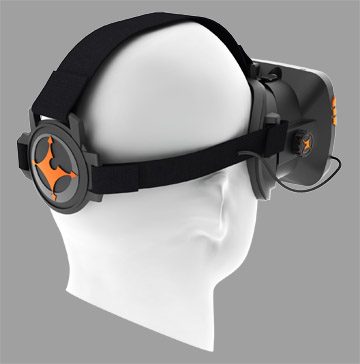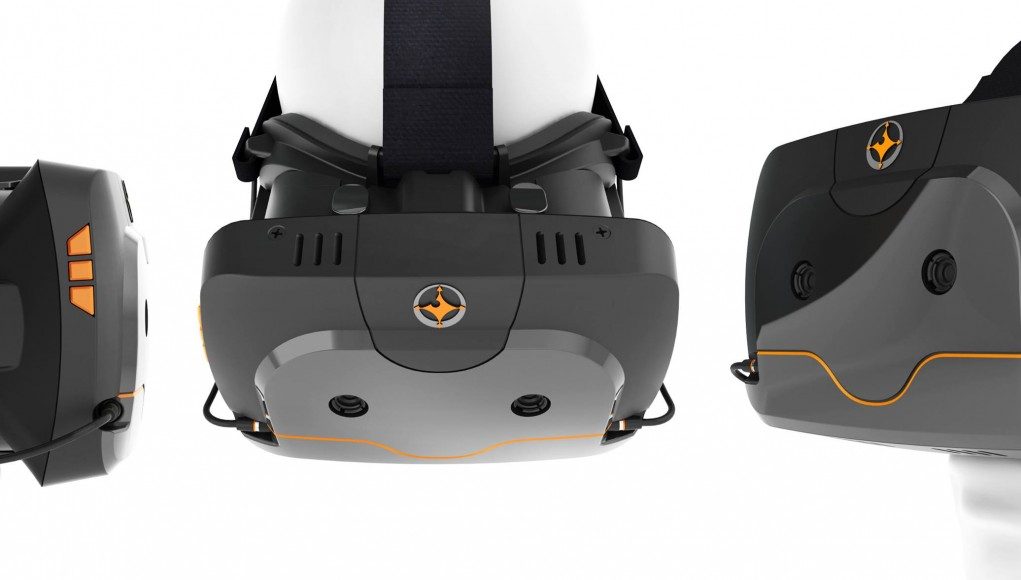Road to VR talks with Bertrand Nepveu, the CEO and Founder of True Player Gear. They’re working on a VR headset, which will compete with the Oculus Rift, called ‘Totem.’ The company created quite a buzz in the VR world since announcing their existence following the Facebook acquisition of Oculus VR.
The True Player Gear Totem is a VR headset with similar specs to the Oculus Rift DK2. The final spec is planned to include a 1080p OLED display with low persistence and a 90 degree field of view. Unlike the Rift, it also has two 1080p cameras on the front that will allow for passthrough video and positional tracking. It contains onboard stereo surround sound and will have compatibility with PCs as well as game consoles.
The Totem, which was announced shortly after Facebook’s Oculus buyout, appeared to some to be vaporware or an empty promise. To others, it appeared to be the best alternative for those wanting to jump off the Oculus Rift boat. Bertrand Nepvue was kind enough to speak with me to set the story straight.
Road to VR: Other than posting a few teasers, you haven’t talked to any news outlets yet. Why come out now?
Nepveu: To be honest, for me to give Road to VR the first interview is really important. I have been following Road to VR for some time, and the community is very important to me. We know that our product isn’t mass market ready yet, and we still have a few milestones to achieve. We want to build a core group of fans that are willing to experiment a little bit, and then once we nail all of the core problems, we can go mass market.
Road to VR: You’ve put out a few posts online that caused quite a number of skeptics to speak out, including myself. What do you think about that?
Nepveu: It’s normal. Competition is good, but I don’t see Oculus as a competitor, right now I see them as a fellow company who is trying to make VR the next big thing. So, when I saw all of the opposition and the rants on the internet, I was stunned. We were trying to give people hope, that there was another option. We tried to put out as many details as possible so we don’t seem fake.
When Facebook bought Oculus, some of the concerns were from the indie developers, who spent so much time on their games, and are ready to release it. But now they see that Facebook is involved, and they don’t know whether things will change for them. When I posted about our product, I only did it in the VR section of reddit because I didn’t want this to go mainstream yet. I knew that there would be a group of developers that would be happy to hear that there is an alternative.
“Competition is good, but I don’t see Oculus as a competitor, right now I see them as a fellow company who is trying to make VR the next big thing”
News about our product didn’t go viral until the day after we posted it. Someone shared it in the technology section of reddit and we started getting loads of hits to our site. Some people have said that we are being opportunistic and this is a marketing scam. Did we want to let developers know we existed? Yes. Did we want to start doing interviews and get all of this attention? No. That was not my plan, because we are still a month or two away from releasing a press demo.
Road to VR: How big is your team and what is your background?
Nepveu: We are a team of five people. We have outside consultants, but the core group is five people. We are all engineers, two computer engineers and three electrical engineers. We started with just two of us, and slowly added more people. We knew we didn’t want to miss the VR wave, so we added more.
Road to VR: Let’s address some of the points of contention that have arisen about your product. Let’s start with how long you’ve been a company and how long you’ve been working on this. People are skeptical about the fact that you have been working for nine years on a VR headset.

Nepveu: A bit of history first then. I was doing my MBA in 2004-05, and I was reading an article about the Xbox 360. I am a big gamer, and I love both consoles and PC games. I knew back then that in order to have a good VR experience, you needed to have a controlled environment, and to be plug-and-play. If people had a bad time with VR, it would crash and burn. For me, VR redemption would have to come from a console. For the first time in history, with the Xbox 360, a console will be able to have enough power to give a good VR experience.
So, I started to look for components on the internet, which led me to find a few VGA [640×480] resolution microdisplays. From there, I contacted one of my ex-colleagues and asked him if he wanted to work on this to see if we could make something for VR. Back then, the screens were terrible, and we had to use accelerometers since gyroscopes and other sensors didn’t even exist yet. This caused our first generation HMD to have really bad drift, and we knew there was no way we could put this on the market. As newer and better parts became available, we made a second generation. People ask us why it took us nine years, and I tell them, ‘VR is hard and you need a great experience, and the technology was not there yet’.
“People can say that we copied, but we had been working on this for so long”
Last year at CES, we showed a few companies our third generation prototype. It had SVGA [800×600] screens and a 45 degree field of view. We wanted a higher field of view, but the microdisplays were so small that the lenses were already cumbersome enough. At the time, other HMDs were only showing 45 degrees, so we felt that we were okay. We hadn’t seen the Oculus Rift yet.
Road to VR: Now that we know this story, I am curious as to your reaction to Palmer Luckey and John Carmack coming out and showing off their Rift for the first time.
Nepveu: I had mixed feelings. The first time I heard about them was the John Carmack video at E3. I thought, if John Carmack is excited about it, there must be something to it. The timing was funny. We were about to show our prototype in Boston to the company that was providing our microdisplays. I worked all night to finish everything. The next morning, I see the Rift video, and I said to myself, here is one more guy who is bringing some new ideas to VR, and maybe it will do something great. When the Kickstarter began, I ordered one.
With our microdisplays, there was no screen door, there was no latency, everything was crisp and quick, but it wasn’t immersive. The first time I tried our Rift, the screen door effect and blurring made me think that the RIft would crash and burn. I had a headache after playing Team Fortress 2. I tried it again a few days later, again with Team Fortress 2, and I had a breakthrough moment. Eventually, my body got used to it and I was able to ignore the screen door. I was dodging rockets and moving around and I was really having fun. Then, I looked down and saw my body and realized that I wasn’t controlling an avatar, I was the avatar. That was the moment that we decided to scrap the 45 degree field of view and had to go 90 degrees. It was hard because we had been working with microdisplays for so long. But that is the way technology works. If there is a breakthrough that can make your product better, you use it.
People can say that we copied, but we had been working on this for so long, and our tracking was already really good. We just decided to switch to the different screen. A microdisplay cost $100 apiece and we needed two of them. With the Rift at $300, we would never be able to compete with that with our current technology.
Road to VR: Let talk about your current model and design. The specs are similar to the Oculus Rift DK2. 1080p OLED with low persistence, 90 degree FOV, positional tracking, etc. You have one feature that the Rift does NOT have, two cameras in front. Are they meant for tracking or passthrough or both?
Nepveu: They are multipurpose. There are two 1080p cameras on the front. Passthrough will work right out of the box. Once you have the optics set up, you won’t need to wear your glasses. We have our own optics optimized for an OLED screen. They will be able to focus for you to compensate for your prescription. You want to find your keyboard and not take off your HMD, you hit a button and you will be able to see through the cameras. We will also use them for positional tracking. There are several thoughts on how to do this. We felt the best way to do it would be the way the brain does it, similar to what Valve showed. With two cameras, you can calculate distance and depth with external markers, probably LEDs, strategically placed in your environment.

Road to VR: The cameras are not going to be movable. How are you going to account for people having different IPDs and want to use the passthrough option?
Nepveu: It’s like when they film a 3D movie. It is done at an average distance. We have set our IPD for the cameras at the average 64mm. Since we have a 1080p screen, there is enough room that we can artificially crop and shift the image from the cameras to give a different IPD.
Road to VR: Your lenses will be able to adjust for my glasses prescription. Oculus is providing different lenses, what are you doing?
Nepveu: The lens just needs to be closer or farther away from the screen to compensate for your prescription. You can adjust that using the knobs on the top of our HMD. Also, like The Oculus Rift, we have knobs to adjust the distance from the face.
Road to VR: Since you have cameras with passthrough, is there a chance that we can use the Totem VR headset for augmented reality as well?
Nepveu: It is certainly possible. We are interested in seeing what the development community will create. The hardware supports it, there just needs to be software developed. There is a lot of opportunity there.
Road to VR: You spoke about doing a crowd-funded campaign in the next few months with hopes to gather $500K. What are your plans?
Nepveu: One of the main problems is that you need to have enough people supporting you. The unintentional attention we got from reddit in the last few days will help our chances for success. We worked so long and so hard that we don’t want to fail. Investors want validation. Venture capitalists need validation before they will invest. We aren’t planning on giving ourselves big salaries or anything. Crowdfunding will take care of the machining and the development. $500K will allow us to break even. Would we love to get more, but that is up to the community to decide.
“The unintentional attention we got from reddit in the last few days will help our chances for success. We worked so long and so hard that we don’t want to fail.”
Road to VR: Is your expectation that you will build 50K development kits? What do you think the cost would be for a development kit?
Nepveu: That would be a great thing, but we are aiming more at 1,000-2,000 units. Our cost will be a bit more than the Oculus Rift because we are providing more hardware and more options for developers to play with. We are seeing in the forums that people are willing to pay a bit more for the added features we are providing. That is what we are focusing on in the next month or two. We want to get our pricing solidified and determine costs.
Road to VR: You’ve mentioned that you are planning on getting a development kit out by Christmas. What about a consumer product?
Nepveu: Right now, our current model is 1080p. We think that the screen needs to be better for a consumer product. The problem is that a 4K screen requires a really good graphics card to push it. It is about the balance between power and performance. We are really focusing on the development kit first and see what developers think of it.
 Road to VR: How about your latency and the weight of your product?
Road to VR: How about your latency and the weight of your product?
Nepveu: We are using a lot of similar technology as Oculus. We do strobing like them for low persistence. We have hardware acceleration. I don’t see how it could be much different from the Oculus Rift. As far as weight goes, we don’t have an exact number yet because we are still assembling our latest generation. It will be heavier than the Rift because we have larger optics, and other components, but it will not be much more.
Road to VR: You claim that Totem will be able to work with a variety of consoles. How is that possible?
Nepveu: Similar to the injection drivers that are available [for the Oculus Rift], some games will work, some won’t. Our original focus in the beginning was to be compatible with the Xbox 360. Our patents focus on that. We knew that Microsoft wasn’t going to support us, so we went the direction of emulating the gamepad. Looking around with your HMD controls the thumb stick movement. Ideally, a 3D SBS game is what we want, but we have the ability to use frame buffering to handle other 3D options. Will it be perfect? It will depend on the type of game and what the developers decide to make. If it turns out that there won’t be enough titles for it, then we will drop that feature. We could even try to emulate Sony’s Morpheus down the road.
Road to VR: Are you planning on releasing an SDK?
Nepveu: Many game engines are already adding HMD support. One of the problems in the industry is that there isn’t a standard. Our plan is to have as small an SDK as possible. Steam is really big, and gives a console experience on the PC. We want to provide users with as easy an experience as possible. We prefer to integrate with OpenVR which is an existing SDK and is a good standard.
Road to VR: Do you have any patents for your technology?
Nepveu: The worst thing that could happen right now in the VR community is a patent war. If companies start to go back and forth with patents, it will kill every little project. Valve has the right idea with sharing their knowledge about presence. We applied for two patents, but suing others is definitely not part of our business plan.
Road to VR: Many people are looking at your product as the best alternative to the Oculus Rift since they don’t like the news about Facebook purchasing them. What is your response to that? Are you going to maintain the community spirit and not sell out?
Nepveu: I read an article in the New York Times that Facebook may have purchased Oculus too early because they don’t have a consumer product yet. When I heard the news, I originally thought it was a joke. When I finally came to terms with it, I realized that this might be good for us. When Oculus started posting that they couldn’t believe the negative response to the news, I thought that maybe they should have asked the community first before making this decision. Can I say that we will stay independent forever? No. Is the community important to us? Yes. We would get the pulse of the community before making a decision like that.
Road to VR: Why the name ‘Totem’?
Nepveu: It isn’t our final name. Things change with time. A Totem is a reference to the movie, Inception. Their Totem allows them to know if they are in the real world or a simulation. We plan to do a survey and let the community name it. We trust the community.
—
True Player Gear is based in Montreal, Canada. Once a working prototype is available, Road to VR will be there to test it out first hand. To keep up with news on their product as is becomes available, sign up for the mailing list at their website. I’d like to thank Bertrand Nepveu for taking the time to answer our questions.








